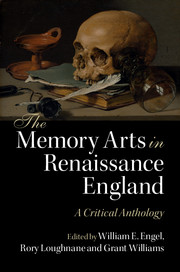Book contents
- Frontmatter
- Dedication
- Contents
- List of figures
- Acknowledgements
- A note on abbreviations
- Introduction
- PART I The art of memory
- PART II Rhetoric and poetics
- Introduction to Part II
- II.1 Anon., Table of Cebes (1531)
- II.2 Thomas Wilson, The Art of Rhetoric (1553)
- II.3 George Puttenham, The Art of English Poesy (1589)
- II.4 Henry Peacham, The Garden of Eloquence (1593)
- II.5 Philip Sidney, The Defence of Poesy (1595)
- II.6 Francis Meres, Palladis tamia (1598)
- II.7 Samuel Daniel, Musophilus (1599)
- II.8 Miles Sandys, Prudence (1634)
- II.9 Ben Jonson, Timber, or, Discoveries (1641)
- II.10 Alexander Ross, Mystagogus poeticus (1648)
- PART III Education and science
- PART IV History and philosophy
- PART V Religion and devotion
- PART VI Literature
- Index
Introduction to Part II
from PART II - Rhetoric and poetics
Published online by Cambridge University Press: 05 August 2016
- Frontmatter
- Dedication
- Contents
- List of figures
- Acknowledgements
- A note on abbreviations
- Introduction
- PART I The art of memory
- PART II Rhetoric and poetics
- Introduction to Part II
- II.1 Anon., Table of Cebes (1531)
- II.2 Thomas Wilson, The Art of Rhetoric (1553)
- II.3 George Puttenham, The Art of English Poesy (1589)
- II.4 Henry Peacham, The Garden of Eloquence (1593)
- II.5 Philip Sidney, The Defence of Poesy (1595)
- II.6 Francis Meres, Palladis tamia (1598)
- II.7 Samuel Daniel, Musophilus (1599)
- II.8 Miles Sandys, Prudence (1634)
- II.9 Ben Jonson, Timber, or, Discoveries (1641)
- II.10 Alexander Ross, Mystagogus poeticus (1648)
- PART III Education and science
- PART IV History and philosophy
- PART V Religion and devotion
- PART VI Literature
- Index
Summary
Roman oratory was organised around five canons to compose and present speeches (invention, arrangement, style, memory and delivery), equipping an educated class to persuade auditors in a competitive public forum. The fourth canon, as the art of memory, specifically gave strategies for recalling a speech's primary points involving an architectural mnemonic design which, during medieval times, suffered serious decline. Monastic education fostered a manuscript culture seeking to understand Holy Writ through dialectic or logic instead of rhetorical resources, which were relegated to teaching letter-writing and homiletics. In this didactic environment, the grid memory technique for teaching schoolboys how to memorise biblical passages superseded the image-place system used to recall a declamation's ordered arguments.
With the rediscovery of Cicero's and Quintilian's core texts by Renaissance humanists hungry for learning about classical literature and culture, rhetoric underwent a pedagogical revival. Tudor authors developed their literacy through the humanist rhetorical curriculum, which began with teaching classical Latin in grammar schools, often employing short moral texts like Table of Cebes (II.1), and continued at Oxford, Cambridge and London's law schools (the Inns of Court), where classical writers were studied and admired. Consequently, rhetorical conventions, forms and genres mediated the thinking of literate Englishmen in their speech, writing and reading. This brought renewed attention to the fourth canon. For example, Hawes's Pastime of Pleasure (I.1) inserts the image-place system within five-part oratory, as does Wilson's Art of Rhetoric (II.2), which offers the fullest treatment of Ciceronian oratory in English.
The art of memory, however, was evicted from its oratorical home during the second half of the sixteenth century, when English writers and pedagogues increasingly reflected structural changes that continental humanists wrought in rhetoric. Erasmus, Melanchthon and above all Peter Ramus picked over and modified the parts of canonical oratory to advance literacy within the parameters of print culture and pedagogical reform. Ramus relocated the canons of invention and arrangement to dialectic, leaving rhetoric only with style and delivery. His restriction of eloquence to ornamentation can be seen in English handbooks devoted to figures of speech, exemplified by Peacham (II.4). His logical arrangement of figures exhibits the Ramist method, by which topics and discourses were dichotomised into ever smaller branching divisions such that the ensuing synoptic order enabled students to grasp bookish materials comprehensively yet easily.
- Type
- Chapter
- Information
- The Memory Arts in Renaissance EnglandA Critical Anthology, pp. 103 - 108Publisher: Cambridge University PressPrint publication year: 2016



